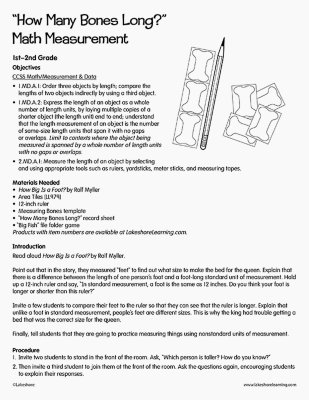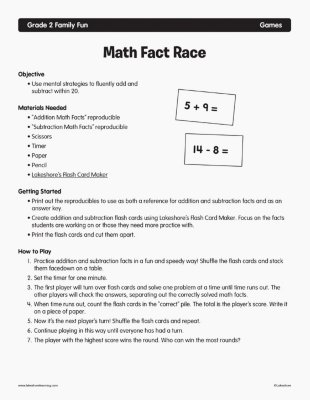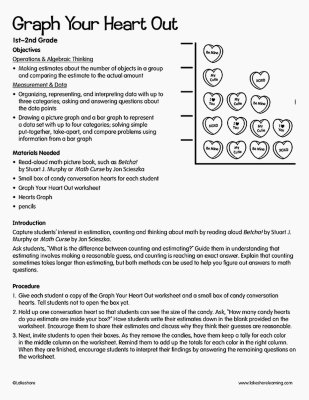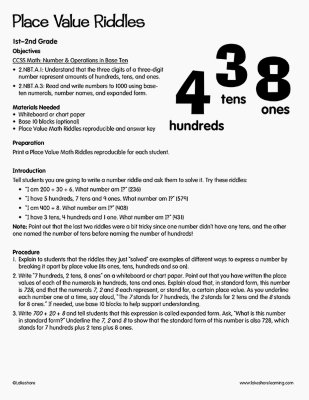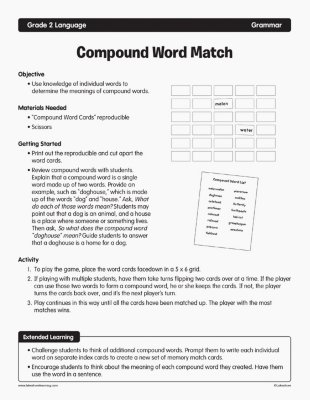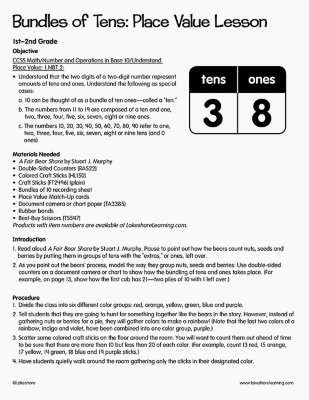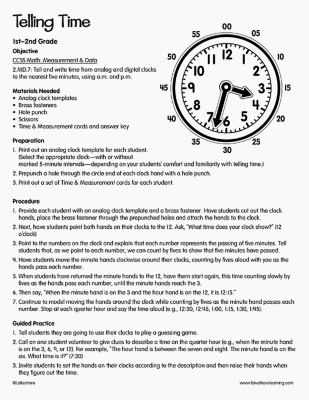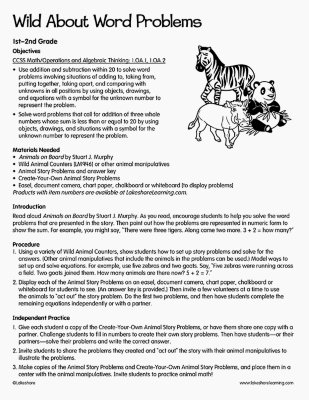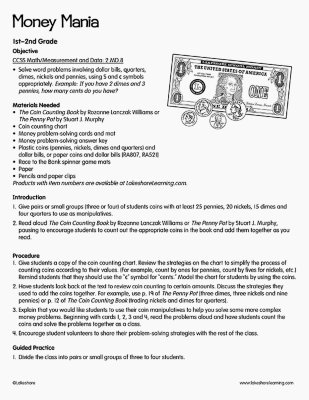Narrow by Grade
- Infant (0)
- Toddler (0)
- Preschool (0)
- Pre-K (0)
- Kindergarten (0)
- 1st (4)
- 2nd (9)
- 3rd (0)
- 4th (0)
- 5th (0)
- 6th & Up (0)
Grade
Narrow by Age
- 0-18m (1)
- 18-36m (5)
- 3 yrs. (0)
- 4 yrs. (5)
- 5 yrs. (8)
- 6 yrs. (8)
- 7 yrs. (9)
- 8 yrs. (7)
- 9 yrs. (6)
- 10 yrs. (3)
- 11 yrs. & Up (0)
Age 7 yrs.
9 results for "individual hands-on math kit"
Filters
Clear All
"How Many Bones Long?" Math Measurement
1st Grade - 2nd Grade
Objectives CCSS Math/Measurement & Data 1.MD.A.1: Order three objects by length; compare the lengths of two objects indirectly by using a third object. 1.MD.A.2: Express the length of an object as a whole number of length units, by laying multiple copies of a shorter object (the length unit) end to end; understand that the length measurement of an object is the number of same-size length units that span it with no gaps or overlaps. Limit to contexts where the object being measured is spanned by a whole number of length units with no gaps or overlaps. 2.MD.A.1: Measure the length of an object by selecting and using appropriate tools such as rulers, yardsticks, meter sticks, and measuring tapes. Materials Needed How Big Is a Foot? by Rolf Myller Area Tiles 12-inch ruler Measuring Bones template “How Many Bones Long?” record sheet “Big Fish” file folder game Introduction Read aloud How Big Is a Foot? by Rolf Myller. Point out that in the story, they measured “feet” to find out what size to make the bed for the queen. Explain that there is a difference between the length of one person’s foot and a foot-long standard unit of measurement. Hold up a 12-inch ruler and say, “In standard measurement, a foot is the same as 12 inches. Do you think your foot is longer or shorter than this ruler?” Invite a few students to compare their feet to the ruler so that they can see that the ruler is longer. Explain that unlike a foot in standard measurement, people’s feet are different sizes. This is why the king had trouble getting a bed that was the correct size for the queen. Finally, tell students that they are going to practice measuring things using nonstandard units of measurement.
View Lesson PlanMath Fact Race
2nd Grade
Objective
- Use mental strategies to fluently add and subtract within 20.
Graph Your Heart Out
1st Grade - 2nd Grade
Objectives Operations & Algebraic Thinking Making estimates about the number of objects in a group and comparing the estimate to the actual amount Measurement & Data Organizing, representing, and interpreting data with up to three categories; asking and answering questions about the data points Drawing a picture graph and a bar graph to represent a data set with up to four categories; solving simple put-together, take-apart, and compare problems using information from a bar graph Materials Needed Read-aloud math picture book, such as Betcha! by Stuart J. Murphy or Math Curse by Jon Scieszka Small box of candy conversation hearts for each student Graph Your Heart Out worksheet Hearts Graph pencils Introduction Capture students’ interest in estimation, counting and thinking about math by reading aloud Betcha! by Stuart J. Murphy or Math Curse by Jon Scieszka. Ask students, “What is the difference between counting and estimating?” Guide them in understanding that estimating involves making a reasonable guess, and counting is reaching an exact answer. Explain that counting sometimes takes longer than estimating, but both methods can be used to help you figure out answers to math questions.
View Lesson PlanPlace Value Riddles
2nd Grade
Objectives CCSS Math: Number & Operations in Base Ten 2.NBT.A.1: Understand that the three digits of a three-digit number represent amounts of hundreds, tens, and ones. 2.NBT.A.3: Read and write numbers to 1000 using base-ten numerals, number names, and expanded form. Materials Needed Whiteboard or chart paper Base 10 blocks (optional) Place Value Math Riddles reproducible and answer key Introduction Tell students you are going to write a number riddle and ask them to solve it. Try these riddles: “I am 200 + 30 + 6. What number am I?” (236) “I have 5 hundreds, 7 tens and 9 ones. What number am I?” (579) “I am 400 + 8. What number am I?” (408) “I have 3 tens, 4 hundreds and 1 one. What number am I?” (431) Note: Point out that the last two riddles were a bit tricky since one number didn’t have any tens, and the other one named the number of tens before naming the number of hundreds!
View Lesson PlanCompound Word Match
2nd Grade
Objective
- Use knowledge of individual words to determine the meanings of compound words.
Bundles of Tens: Place Value Lesson
1st Grade - 2nd Grade
Objective CCSS Math/Number and Operations in Base 10/Understand Place Value: 1.NBT.2: Understand that the two digits of a two-digit number represent amounts of tens and ones. Understand the following as special cases: 10 can be thought of as a bundle of ten ones—called a “ten.” The numbers from 11 to 19 are composed of a ten and one, two, three, four, five, six, seven, eight or nine ones. The numbers 10, 20, 30, 40, 50, 60, 70, 80, 90 refer to one, two, three, four, five, six, seven, eight or nine tens (and 0 ones). Materials Needed A Fair Bear Share by Stuart J. Murphy Double-Sided Counters Colored Craft Sticks Craft Sticks (plain) Bundles of 10 recording sheet Place Value Match-Up cards Document camera or chart paper Rubber bands Best-Buy Scissors Introduction Read aloud A Fair Bear Share by Stuart J. Murphy. Pause to point out how the bears count nuts, seeds and berries by putting them in groups of tens with the “extras,” or ones, left over. As you point out the bears’ process, model the way they group nuts, seeds and berries: Use double-sided counters on a document camera or chart to show how the bundling of tens and ones takes place. (For example, on page 13, show how the first cub has 21—two piles of 10 with 1 left over.)
View Lesson PlanTelling Time
2nd Grade
Objective CCSS Math: Measurement & Data 2.MD.7: Tell and write time from analog and digital clocks to the nearest five minutes, using a.m. and p.m. Materials Needed Analog clock templates Brass fasteners Hole punch Scissors Time & Measurement cards and answer key
View Lesson PlanWild About Word Problems
1st Grade - 2nd Grade
Objectives CCSS Math/Operations and Algebraic Thinking: 1.OA.1, 1.OA.2 Use addition and subtraction within 20 to solve word problems involving situations of adding to, taking from, putting together, taking apart, and comparing with unknowns in all positions by using objects, drawings, and equations with a symbol for the unknown number to represent the problem. Solve word problems that call for addition of three whole numbers whose sum is less than or equal to 20 by using objects, drawings, and situations with a symbol for the unknown number to represent the problem. Materials Needed Animals on Board by Stuart J. Murphy Wild Animal Counters or other animal manipulatives Animal Story Problems and answer key Create-Your-Own Animal Story Problems Easel, document camera, chart paper, chalkboard or whiteboard [to display problems] Introduction Read aloud Animals on Board by Stuart J. Murphy. As you read, encourage students to help you solve the word problems that are presented in the story. Then point out how the problems are represented in numeric form to show the sum. For example, you might say, “There were three tigers. Along came two more. 3 + 2 = how many?”
View Lesson PlanMoney Mania
2nd Grade
Objective CCSS Math/Measurement and Data: 2.MD.8 Solve word problems involving dollar bills, quarters, dimes, nickels and pennies, using $ and ¢ symbols appropriately. Example: If you have 2 dimes and 3 pennies, how many cents do you have? Materials Needed The Coin Counting Book by Rozanne Lanczak Williams or The Penny Pot by Stuart J. Murphy Coin counting chart Money problem-solving cards and mat Money problem-solving answer key Plastic coins (pennies, nickels, dimes and quarters) and dollar bills, or paper coins and dollar bills Race to the Bank spinner game mats Paper Pencils and paper clips Introduction Give pairs or small groups (three or four) of students coins with at least 25 pennies, 20 nickels, 15 dimes and four quarters to use as manipulatives. Read aloud The Coin Counting Book by Rozanne Lanczak Williams or The Penny Pot by Stuart J. Murphy, pausing to encourage students to count out the appropriate coins in the book and add them together as you read.
View Lesson Plan